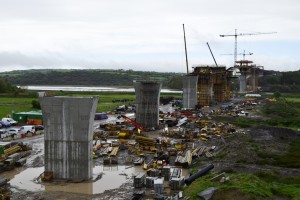The €230 million N25 New Ross Bypass project is advancing on schedule, with more than two thirds of the Private Public Partnership (PPP) contract now completed.
The scheme, which is due to open next year and has employed up to 300 people on site, is being delivered by the Royal BAM Group and the ACS Group, which previously delivered the N25 Waterford Bypass. Once completed, the project will consist of a 14-kilometre dual carriageway, including new sections of both the N25 and N30 National Primary Routes, with the three tower, 900-metre long Barrow Bridge forming the centrepiece of the development, linking Pink Rock in South Kilkenny to Strokestown in West Wexford.
The ‘Extrados’-type bridge will not only become the longest bridge in Ireland, but it will also be the longest bridge of this kind in the world, and upon completion will be one of the most prominent landmarks in the South East.
The edge sections of the bridge’s deck are now in place on the Kilkenny side of the project, while a full ‘circulatory’ roundabout is due to be in place on the N25 at Glenmore by mid-June. Meanwhile, eight of the nine road bridges on the Wexford flank of the scheme “are not complete or substantially complete and associated road realignments (are) open to traffic” according to Kilkenny County Council. Advance works led to some significant archaeological discoveries on the bypass site, according to James Eogan, Transport Infrastructure Ireland’s (TII) Senior Archaeologist.
A total of 29 previously unknown/undocumented sites were revealed, “including the foundations of a wooden building, uncovered at Ryleen, east of New Ross” which was “built by some of the first Stone Age (Neolithic) farmers who cleared the primeval forests, planted crops and raised their livestock in this area almost 6,000 years ago”.
Added to this, a “significant discovery” was made just off the Campile (R733) road, where remains of a 14th Century farm were unearthed.
Its significance, stated Mr Eogan is due to the fact that “more modest (Norman) dwellings associated with the majority of the population of the time are almost impossible to identify without the sort of extensive archaeological work carried out in advance of road construction”. Cremation burials were also identified at Camlin, Stokestown and Berkeley which reveal “how our Bronze Age forbears treated deceased members of society 3-4,000 years ago”.


